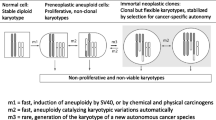Summary
Electrophoretically pure mouse interferon induced the progressive reversion of the transformed phenotype of a clone of X-ray transformed C3H/10T1/2 cells. Cells of this clone did not harbor C-type particles and reverse transcriptase activity was not detected. Interferon-treated transformed cells were aligned without cellular overlapping and attained low cell densities. Morphologic changes were associated with the appearance of a thick layer of submembranous microfilaments. The tumorigenicity of interferon-treated cells was markedly reduced. Back reversion to the transformed phenotype occurred progressively when these cells were passaged in the absence of interferon. These results suggest that interferon may induce the reversion of the transformed phenotype by a mechanism other than by its antiviral activity.
Similar content being viewed by others
Literatur
Brouty-Boyé, D., and Gresser, I., Reversibility of the transformed and neoplastic phenotype. I. Progressive reversion of the phenotype of x-ray-transformed C3H/10T1/2 cells under prolonged treatment with interferon. Int. J. Cancer28 (1981) 165–173.
Brouty-Boyé, D., Gresser, I., and Baldwin, C., Decreased sensitivity of interferon associated within vitro transformation of X-ray-transformed C3H/10T1/2 cells. Int. J. Cancer24 (1979) 261–265.
Tovey, M. G., Begon-Lours, J., and Gresser, I., A method for the large scale production of potent interferon preparatite/ Proc. Soc. exp. Biol. Med. (N.Y.)146 (1974) 809–815.
Aguet, M., High affinity binding of125I-labelled mouse interferon to a specific cell surface receptor. Nature, Lond.284 (1980) 459–461.
Aguet, M., and Blanchard, B., High affinity binding of125I-labelled mouse interferon to a specific cell surface receptor. II. Analysis of binding properties. Virology115 (1981) 249–261.
Bourgeade, M-F., Rousset, S., Paulin, D., and Chany, C., Reorganization of the cytoskeleton by interferon in MSV-transformed cells. J. Interferon Res.1 (1981) 323–332.
Brouty-Boyé, D., Cheng, Y. S. E., and Chen, L. B., Association of phenotypic reversion of transformed cells induced by interferon with morphological and biochemical change in the cytoskeleton. Cancer Res.41 (1981) 4174–4184.
Hicks, N. J., Morris, A. G., and Burke, D. C., Partial reversion of the transformed phenotype of murine sarcoma virus transformed cells in the presence of interferon: a possible mechanism for the antitumor effect of interferon. J. Cell Sci.49 (1981) 225–236.
Wang, E., Pfeffer, L. M., and Tamm, I., Interferon increases the abundance of submembranous microfilaments in HeLa-S3 cells in suspension culture. Proc. natl Acad. Sci. USA78 (1981) 6281–6285.
Author information
Authors and Affiliations
Additional information
Acknowledgments. This work was aided by grants from I.N.S.E.R.M. (contract No 80-2003 and 81-2008), and D.R.E.T. (contract No 34-80-522). We are grateful to Mrs C. Maury for her technical assistance.
Rights and permissions
About this article
Cite this article
Brouty-Boyé, D., Puvion-Dutilleul, F. & Gresser, I. Reversibility of the transformed and neoplastic phenotype. III. Long-term treatment with electrophoretically pure mouse interferon leads to the progresive reversion of the phenotype of X-ray transformed C3H/10T1/2 cells. Experientia 38, 1292–1296 (1982). https://doi.org/10.1007/BF01954916
Published:
Issue Date:
DOI: https://doi.org/10.1007/BF01954916




